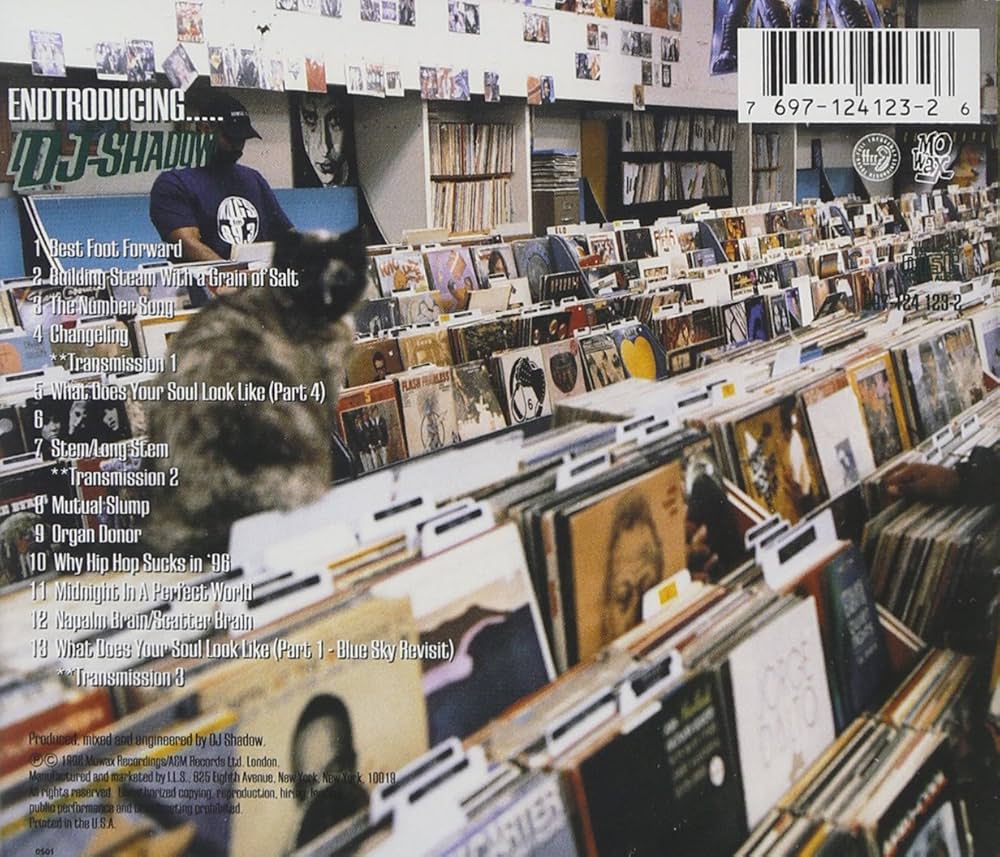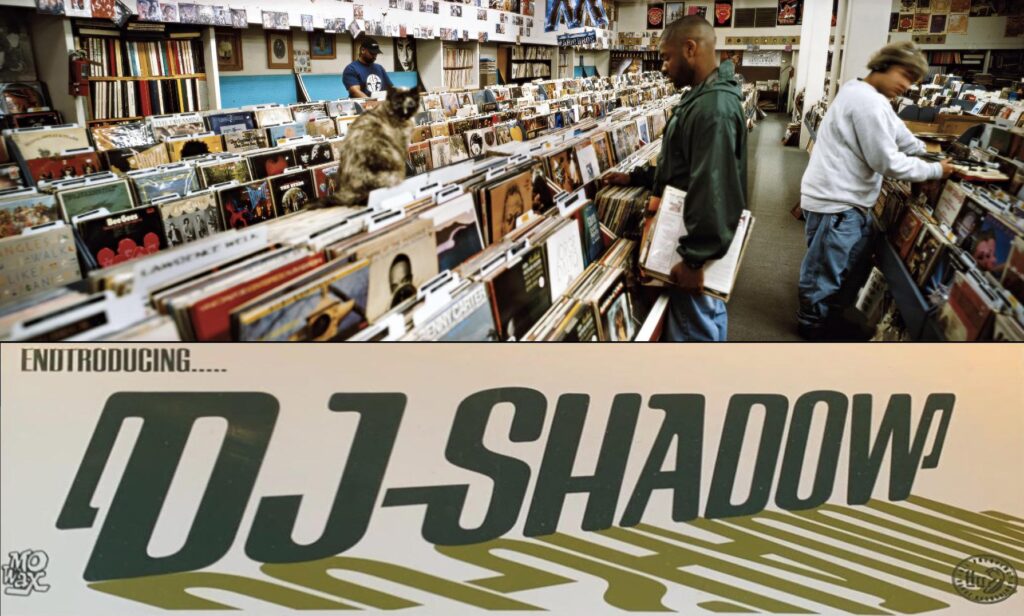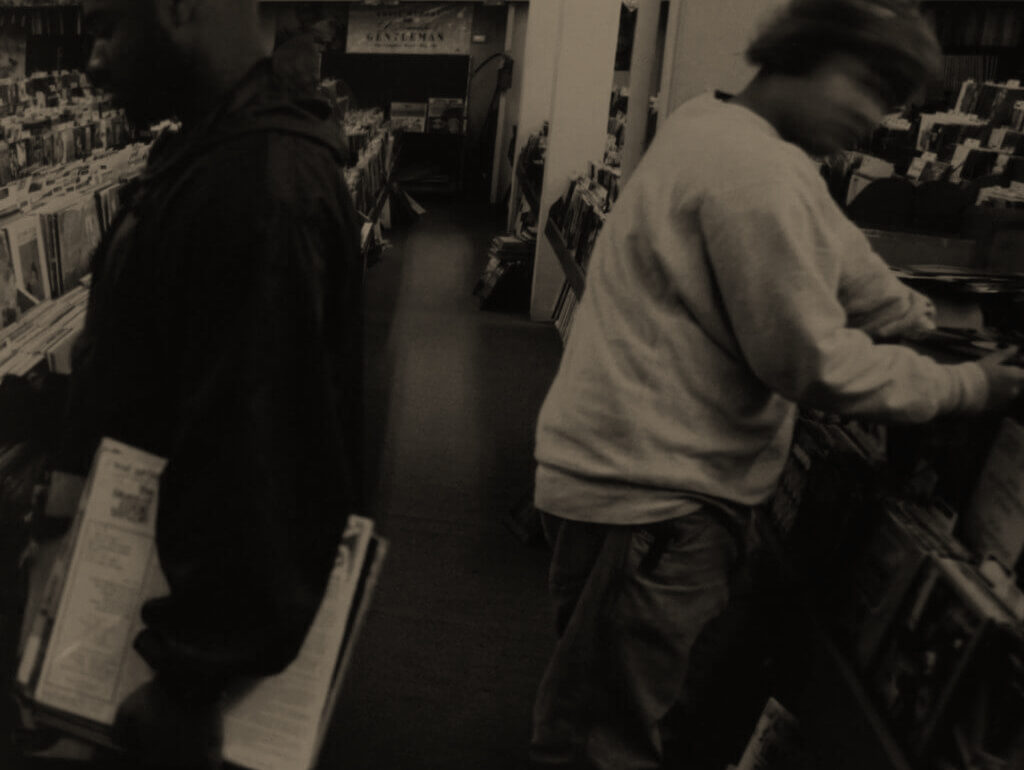
DJ Shadow’s Endtroducing….. crackles like a radio picking up signals from a forgotten era, its beats pulsing with dusty grooves and its mood shifting like a dream you can’t quite pin down. Released in 1996 on Mo’ Wax, this debut from Josh Davis, a crate-digging kid from Davis, California, redefined instrumental Hip Hop. Built entirely from samples—hundreds of them, pulled from obscure jazz, funk, rock, and spoken-word records—it weaves a hypnotic, hour-long collage that’s dense with texture and heavy with feeling. From the eerie hum of “Best Foot Forward” to the sprawling closer “What Does Your Soul Look Like (Part 1 – Blue Sky Revisit),” the album moves like a late-night drive through a city of ghosts, its sound vivid, its structure loose yet deliberate.
Davis, barely out of college when he made Endtroducing…., spent years scouring record shop basements, treating vinyl like an archaeologist unearthing relics. His tools—an AKAI MPC60, turntables, and Pro-Tools—turned those finds into gold. “Best Foot Forward” opens with a playful jab, chopping battle-rap boasts into a 50-second intro that hums with turntable scratches and swagger. It’s a quick nod to Hip Hop’s roots before diving into “Building Steam With a Grain of Salt,” where mournful piano loops swirl over thumping drums. A ghostly choir fades in, adding a haunted edge, while wah-wah guitar licks and drum breaks punctuate the track’s brooding vibe. The mood is heavy, like sifting through old memories in a dim attic, yet the groove keeps it alive.
“Building Steam” sets the album’s tone—layered, cinematic, and restless. Davis doesn’t just loop samples; he stacks them into shifting mosaics. “The Number Song” roars with chaotic energy, its pounding drums and metal guitar riffs colliding under a countdown of vocal snippets. A sudden horn breakdown flips the mood, bright and jazzy, before the menace creeps back. It’s disorienting, like a chase scene in a warped action flick. “Changeling” slows the pace, its airy keys and plush guitar licks floating over a funky bassline. Sax notes drift in, serene yet uneasy, as a string section adds quiet tension. The track feels like a calm sea hiding a storm, its seven-minute sprawl letting each layer breathe.
The album’s structure leans on interludes to keep its flow unpredictable. “Transmission 1” crackles with static, a distorted voice muttering about dreams over eerie noise, like a signal from deep space. It’s brief but unsettling, priming the listener for “What Does Your Soul Look Like (Part 4).” Here, a deep bassline anchors jazzy drums and distorted guitars, while a croaking baritone hums in the distance. The track’s calm, meditative vibe invites introspection, its five minutes passing like a fleeting thought. “Untitled,” another interlude, flips to quirky humor—a man rambles about “Maureen’s five sisters” and their “voluptuous” figures over a funky loop, a bizarre detour that adds levity.
“Stem/Long Stem” is the album’s wild heart, a nine-minute beast that swings from calm to chaos. It starts with a familiar piano riff, electronic blips adding a mystic haze, before frenzied drums and metal chords crash in like a storm. Soulful male vocals briefly soothe, only for screeching strings—straight out of a horror flick—to usher in more manic beats. A rant about parking tickets and government paranoia layers on unease, while otherworldly synths swirl. “Long Stem” winds down with gentle strings, but the calm feels fragile after the onslaught. The track’s bipolar shifts mirror a mind racing through panic and peace, its intensity gripping.
“Transmission 2” picks up the eerie thread, its muffled bass and solemn piano evoking a superhero brooding over a city skyline. Static interrupts, linking back to “Transmission 1,” before “Mutual Slump” kicks in with disjointed drums and a doomy hum. Female vocal snippets and a soaring sax line weave through, but the track’s core is its chaotic rhythm, like a machine stuttering to life. “Organ Donor” shifts gears, its organ riff—reminiscent of classic funk—grooving over light drums. The keys veer into discord, improvising wildly, making the track feel alive and unpredictable.
“Why Hip Hop Sucks in ’96” is a sly interlude, its pimped-out funk groove and quick soundbite—“It’s the money!”—poking at commercialism’s grip on the genre. It’s a brief jab before “Midnight in a Perfect World,” the album’s crown jewel. Layered keys glide over pounding drums, female vocals humming softly, while male samples chant “midnight.” The track’s somber warmth feels like driving through a quiet city at 3 a.m., its experimental edge—blurred instruments and scratched vocals—adding a dreamlike glow. It’s accessible yet strange, a perfect distillation of Davis’s vision.
“Napalm Brain/Scatter Brain” lurches with oddity, opening with a sample about dogs and checkers before funky drums and a groovy bassline take over. Wah-wah guitars seduce, then give way to frantic snares and hi-hats, like a rhythm overdosing on adrenaline. Slow-motion strings add a cinematic sweep, the track’s nine minutes shifting from hypnotic to hyper. “What Does Your Soul Look Like (Part 1 – Blue Sky Revisit)” follows, its jazzy sax and soothing vocal melody floating over slick drum rolls. The mood is melancholic, like rain on a window, inviting quiet reflection. “Transmission 3” closes with distorted static and a man’s resigned mutter—“It is happening again”—its sinister smirk leaving a chill.



Endtroducing….’s sound is a gumbo of jazz, funk, soul, rock, and electronica, its mood swinging from serene to paranoid. Davis’s sampling isn’t just technical—it’s emotional. He pulls from Pink Floyd, Björk, Metallica, and forgotten funk 45s, but also B-movie soundtracks and random interviews, giving each sample a new life. A line like “Maureen’s got five sisters” sits alongside tranquil sax solos, both treated with equal care. The album’s structure, with 16 tracks (13 on vinyl), flows like a mixtape—loose, with interludes breaking the rhythm, yet cohesive in its restless energy. Its hour-long runtime passes in a blink, each listen revealing new layers.
The album’s context matters. In 1996, Hip Hop was split—mainstream acts chased radio hits, while underground scenes clung to purism. Davis, a suburban kid, treated Hip Hop as pure innovation, free from dogma. His influences—Public Enemy’s dense collages, Beastie Boys’ sample-heavy sprawl—shine through, but Endtroducing…. carves its own lane. It’s not trip-hop, though it shares that genre’s moody pulse; it’s not strictly Hip Hop, yet its drum-heavy core and cut-and-paste ethos root it there. The album’s creation—nights spent in a Sacramento studio, days digging in record shop basements—infuses it with a loner’s melancholy. Davis called those post-studio drives home, watching the sunrise, a source of the album’s wistful vibe.
Critics initially split on Endtroducing….. Some, like The Wire, dismissed it as gimmicky, favoring Ninja Tune’s output. But time proved them wrong. The album landed on Time’s 100 Greatest Albums list and earned a Guinness World Record as the first fully sampled record. Its influence ripples through J Dilla’s soulful chops, MF DOOM’s quirky loops, and The Avalanches’ sampledelic sprawl. Davis’s refusal to use rappers—calling lyrics “confining”—lets the music breathe, each track a story told through sound alone. “What Does Your Soul Look Like (Part 4)” or “Midnight” could score a film, their cinematic sweep evoking images without words.
Flaws? Few, if any. “Long Stem” drags after “Stem”’s intensity, its calm feeling flat. Some interludes, like “Why Hip Hop Sucks,” are more clever than essential. But these are nitpicks in a work of startling depth. Endtroducing…. is a love letter to vinyl’s forgotten corners—those “broken dreams” Davis found in basements. It’s not about nostalgia; it’s about resurrection, turning scraps into something timeless. The album’s cover—two blurry figures crate-digging—captures its spirit: ordinary moments, transformed into magic. From “Changeling”’s serene haze to “Napalm Brain”’s frantic pulse, Endtroducing…. is a masterclass in mood, rhythm, and the art of listening deeply.



This post was originally published on this site be sure to check out more of their content.







